Introduction
Did you know adults lose 3-8% of muscle mass per decade after 30, accelerating to 10-15% after 50? This condition, called sarcopenia, leads to weakness, frailty, and increased injury risk.
The good news? Muscle loss isn’t inevitable. With the right strategies, you can preserve—and even rebuild—muscle at any age.
In this guide, you’ll discover:
- Why we lose muscle as we age (and how to stop it)
- The best exercises to combat sarcopenia
- Critical nutrition strategies for muscle preservation
- Lifestyle factors most people overlook
- A simple action plan to implement today
Let’s dive in.
Why Do We Lose Muscle With Age?
1. Hormonal Changes
- Testosterone & Growth Hormone Decline (↓ muscle protein synthesis)
- Increased Cortisol (promotes muscle breakdown)
2. “Anabolic Resistance”
- Older muscles respond poorly to protein and exercise stimuli
3. Reduced Physical Activity
- Sedentary lifestyles accelerate disuse atrophy
4. Chronic Inflammation
- Age-related inflammation (inflammaging) breaks down muscle tissue
5. Poor Nutrition
- Inadequate protein intake + micronutrient deficiencies worsen losses
4 Science-Backed Strategies to Prevent Muscle Loss
1. Progressive Resistance Training (Non-Negotiable)
What Works Best:
- Weightlifting (squats, deadlifts, presses) – 2-3x/week
- Bodyweight Exercises (push-ups, pull-ups) – For maintenance
- Band Work – Portable resistance for travelers
Key Research:
- A 2023 meta-analysis found strength training increased muscle mass in seniors by 11% in 12 weeks (Journal of Gerontology).
Pro Tip: Focus on eccentric (lowering) movements – they’re particularly effective for aging muscles.

2. Protein Optimization (Timing & Amount Matters)
Daily Targets:
- 1.2-1.6g protein/kg body weight (e.g., 90-120g for a 75kg person)
- 30-40g per meal to overcome anabolic resistance
Best Sources:
- Animal proteins (whey, eggs, salmon) – Highest leucine content
- Plant combos (tofu + quinoa, beans + rice) – For vegetarians
Critical Timing:
- Consume protein within 2 hours post-workout – Enhances muscle repair
3. Key Nutrients Beyond Protein
| Nutrient | Role | Best Food Sources |
|---|---|---|
| Vitamin D | Supports muscle function | Fatty fish, eggs, sunlight |
| Omega-3s | Reduces inflammation | Salmon, walnuts, algae oil |
| Magnesium | Aids muscle relaxation | Spinach, pumpkin seeds, dark chocolate |
| Creatine | Boosts strength | Meat, supplements |
Supplement Consideration:
- Creatine monohydrate – Shown to increase strength in older adults by 20% (Journal of Strength & Conditioning Research).
4. Lifestyle Adjustments Most Miss
a) Sleep for Recovery
- Aim for 7-9 hours/night – Growth hormone peaks during deep sleep.
b) Stress Management
- High cortisol breaks down muscle – Try meditation or nature walks.
c) Stay Active Daily
- Walk 8,000+ steps/day – Prevents “sedentary atrophy.”
d) Avoid Extreme Diets
- Chronic calorie restriction accelerates muscle loss.
Sample Anti-Sarcopenia Workout Plan
Frequency: 3x/week
| Workout A | Workout B |
|---|---|
| Goblet Squats: 3×8 | Deadlifts: 3×6 |
| Push-Ups: 3×10 | Dumbbell Rows: 3×8 |
| Step-Ups: 2×12/side | Farmer’s Carry: 2×30 sec |
| Plank: 3×30 sec | Side Plank: 2×20 sec/side |
Note: Start light, focus on form, and progressively add weight.
Myths About Aging & Muscle
❌ “Older people can’t build muscle.”
→ Truth: 90-year-olds gain muscle with training (Tufts University Study).
❌ “Walking is enough.”
→ Truth: Resistance training is essential – walking maintains but doesn’t rebuild.
❌ “Protein harms kidneys.”
→ Truth: Safe for healthy kidneys – consult a doctor if you have CKD.

Your Action Plan
- Start lifting – Even 2x/week makes a difference.
- Eat 30g protein/meal – Include eggs, Greek yogurt, or lentils.
- Take vitamin D + omega-3s – Get blood levels checked.
- Track progress – Measure grip strength or thigh circumference.
Key Takeaway
Muscle loss is largely preventable. By combining strength training, smart nutrition, and lifestyle tweaks, you can stay strong, mobile, and independent for decades.
Need a beginner-friendly routine? Download our [Free Sarcopenia Prevention Plan] below!



